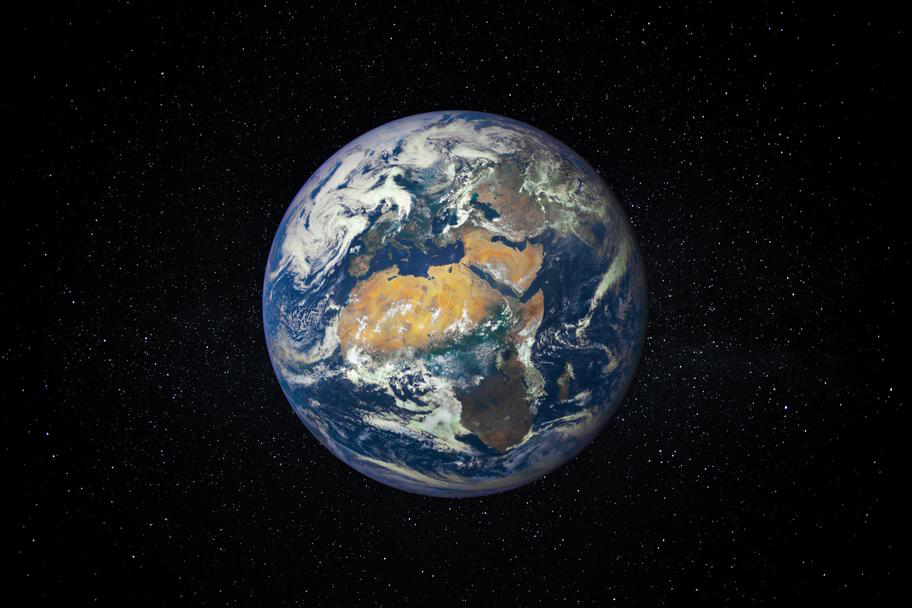Earth

~Masuyo Kosawa
Even as humanity expands among the stars, Earth remains firmly grounded as the seat of human civilization. While colonies on other worlds are expanding rapidly, particularly on Mars and Showalter, more than ninety-eight percent of the human population remains concentrated on its ancestral homeworld.
The cataclysmic Corsica Event caused grievous devastation and loss of life on a scale never before seen in all of human existence. In a matter of days, Earth’s population of 10.5 billion was reduced by 978 million, and the global destruction forever changed Earth’s geography.
The most noticeable physical change the Earth experienced after the Corsica Event was the dramatic 60-foot rise in global sea level. This alone completely reshaped Earth’s coastlines, decreased the size of both ice caps, and increased global temperatures. Most of the deaths during the Corsica Event occurred along coastlines as colossal tsunamis swept into port cities and beachfront communities and never receded. Many peninsula regions, such as Florida, were cut off from the mainland, turning into islands, while many smaller islands were hit so badly by the rising waves that their populations were entirely wiped out. The floodplains of major rivers were invaded by the ocean, transforming them into bays and seas, such as the Lafayette Sea that formed in the Mississippi delta.
While inland regions were largely unaffected by the increase in sea level, they were not entirely spared the destruction. Hurricane storms covered most of Earth’s largest landmasses, ravaging them with high-speed winds and flooding. Electric storms caused monstrous wildfires in the North American west and the Australian Outback. Mild to severe earthquakes struck nearly every fault line on Earth simultaneously.
Numerous thermonuclear explosions occurred across the Earth, though it remains unclear how many of these were caused by the Event itself and how many were human attempts to stop it. Several nuclear reactors melted down during or right after the Corsica Event. Many regions across the Earth remain irradiated to this day.
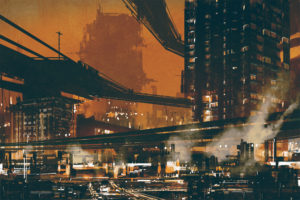
Some of the Corsica tech caused additional effects that cannot yet be explained by science. Massive electromagnetic disturbances swept across most of the Earth, causing its natural electromagnetic field to fluctuate erratically throughout the event, though this effect was not permanent. There are anecdotal accounts of strange visual distortions in the atmosphere, gravitational anomalies, and objects materializing and dematerializing out of thin air. While most of these stranger effects were not reliably documented and did not linger after the Event ended, there are still a few isolated areas across the Earth where space-time itself seems to be off-kilter.
The devastation of the Corsica Event had a tremendous sociopolitical impact. Some governments collapsed, some were restructured, and a scant few who had been spared the brunt of the Corsica Event’s damages were able to take advantage of the suddenly leveled playing field to elevate their economies.
North America
One of the most dramatic regime changes occurred in North America. The United States struggled to adapt during the reconstruction years, thanks in large part to the actions of its controversial populist president Samuel Garlough.
The Corsica Event struck during Garlough’s election year, and by the time of his induction the country was in a state of social and economic upheaval never seen in its history. Against the counsel of his advisors, Garlough devoted most of the country’s emergency relief funds to the construction of a series of levies and seawalls in a futile attempt to reclaim America’s flooded port cities. Of these efforts, only the Manhattan Seawall project was successful, and the other projects were gradually abandoned in various stages of completion.
Garlough’s vain attempts at restoring unsalvageable cities led to even more unrest and desperation among communities nationwide. Riots broke out across the country and approval ratings hit record lows as the American people watched their president dump resources they desperately needed into the sea. When Garlough managed against all odds to win his reelection bid, division among the American people became too much to bear.
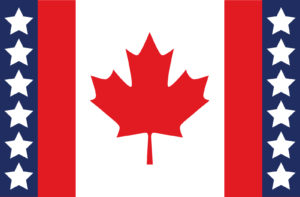
Twelve American states signed the Recusance Pact of 2096, announcing their formal secession from the union in an event that would come to be known as the Great American Schism. The American government lacked the resources to contest this act, and the secession was conducted without large-scale resistance.
Canada was in the process of shedding the last of its monarchial connections, and as part of their governmental restructuring, they extended an invitation to annex the newly seceded American states. This was accepted, and the United North American Republic was born.
This crippled the US government further, and their losses continued to mount. With the loss of the entire Pacific coastline, its oceanic trade capabilities were instantly halved. That same factor effectively cut off supply lines to Alaska and Hawaii, and the two states had little choice but to also secede in the following years, Alaska joining the UNAR and Hawaii joining the newly formed Oceanic Alliance as an independent nation. More than two-thirds of Florida had sunk into the ocean, leaving only a fraction of the panhandle and a swamped island in the Gulf of Mexico. The once great fifty United States had been reduced to 36, and the strength of its economy was already eclipsed by its northern neighbor.
To the immediate south, the Corsica Event had inflicted some of its deadliest carnage. The island nations of the Caribbean were all but obliterated when the tsunamis hit, and some of the smaller islands had been completely consumed by the sea. The larger islands such as Cuba, Haiti, and the Dominican Republic were brutally ravaged, and most Caribbean nations that weren’t completely destroyed still saw their governments collapse in the aftermath.
The devastation and chaos resulted in a mass displacement of Caribbean islanders. Thousands of refugees from every Caribbean nation resettled in the southeastern regions of the United States, taking up residence in the abandoned suburban buildings on the flooded shoreline. The weakened United States government lacked the resources to oppose this mass migration, and soon a largely self-governing nation of Caribbean immigrants had established itself along the coast of the Gulf of Mexico and the Lafayette Sea. While gang warfare was a serious problem in its early days, several of the more influential gangs eventually banded together to protect the community as a whole. The largest of these gangs, a Haitian group called the Mon Ki Pa Nwaye, evolved into a semi-democratic governing body, managing the needs of the community, conducting trade, and protecting their people from outside forces.
South America
South America faired poorly during the Corsica Event, and many of its less stable governments fell to bloody anarchy in its aftermath. Venezuela, Colombia, and Ecuador suffered the simultaneous losses of their executive government leadership, causing tremendous upheaval which culminated in three contiguous civil wars. This conflict, later called the Guerra Rabiosa, or “Rabid War,” was brief but intensely bloody and chaotic. By the time the three nations were able to re-establish order, the borders between them had to be redrawn entirely, and the ownership of some regions remains hotly contested to this day.
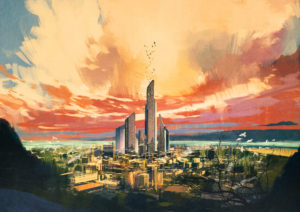
Bolivia and El Salvador also suffered tumultuous transitions of power, but managed to avoid all-out war. Guyana, Suriname, and French Guiana experienced a massive refugee crisis from Venezuelans fleeing the Guerra Rabiosa and Caribbean islanders displaced by the Corsica Event’s floods. Their economies were not strong enough to accommodate the sudden influx on top of their own damages, and sweeping famines plagued the countries for years to come.
Uruguay and Brazil faired better than most, holding onto strong economies after the Corsica Event as their governments coordinated effective reconstruction efforts. Brazil was forced to bolster its military forces to protect its northern border during the Guerra Rabiosa, and it would ultimately be Brazilian intermediaries who would negotiate the ceasefires between warring factions in the destabilized region.
Europe
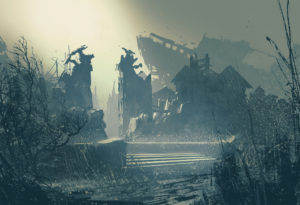
Historians and scientists generally agree that, though its effects were largely decentralized across the globe, the Corsica Event began and ended somewhere in the Mediterranean Sea. Some of the most extensive inland damage occurred in that region, particularly in southern France, Germany, and Italy.
In addition to the catastrophic death toll, countless historic and cultural landmarks and art pieces were destroyed. This, coupled with the state of the global economy, dealt a crippling blow to the vital European tourist industry, further crippling the region’s reconstruction.
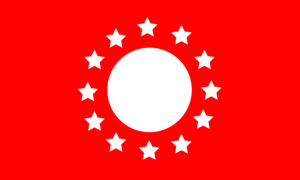
The European Union strained as the needs of its member nations were imbalanced. Those less effected by the Corsica Event, such as the British Isles and the regions to the northeast of the Baltic Sea, chose to focus their resources on their own reconstruction rather than sharing what little they had with the devastated nations to the south. The EU fractured, only the most destitute nations remaining a part of it, clinging to one another as they struggled to pool their scant resources for mutual survival. This incarnation of the European Union would soon evolve into the Expansionary Coalition with the arrival of superluminal space travel technology. Though offworld resources have helped Europe recover to a degree in the ensuing decades, their economies remain on shaky footing.
Asia
The sheer vastness of Asia’s landmass served to diffuse the Corsica Event’s impact, to a degree. The coastal and island regions still suffered greatly, but many of the developed coastal areas along the Asian side of the “Ring of Fire” managed to bounce back faster than similar regions. Most of the major cities in Japan and along the China coast managed to endure, as their infrastructure at the end of the 21st century had some of the most sophisticated anti-tsunami countermeasures on Earth. Additionally, their post-Corsica recovery was aided by the Ming-Kosawa corporation, a Sino-Japanese construction and communications conglomerate that would go on to spearhead reconstruction efforts worldwide.

North Korea experienced a devastating barrage of large thermonuclear detonations during the Corsica Event. Whether these were caused directly by the Event itself, were an act of opportunistic violence by another nation, or were an intentional act of self-destruction remains unknown to this day, but the result was the near-total annihilation of the country’s population. Winds carried radioactive fallout across the South Korean border, leading to public health crises in the northern parts of that nation for decades to come.

India had been in the midst of a societal paradigm shift in the decades leading up to the Corsica Event, with its historically broad class disparity steadily narrowing year by year. Although the death toll and economic impact was no less grievous there than anywhere else, India managed to maintain its momentum thanks to strong leadership and a healthy social safety net. India managed to bounce back from the Corsica Event far quicker than most other nations, and quickly became one of the most influential governments in the new world.
While Russia initially suffered catastrophic losses during the Corsica Event, they were met with unexpected windfalls that aided their recovery. As the global climate warmed dramatically with the rise in sea level, large swaths of previously uninhabitable land in Siberia became temperate enough for human development. While the first two decades of reconstruction were slow due to poor infrastructure and political instability, the country eventually got back on its feet and now enjoys a thriving agrarian economy, becoming one of the world’s largest food producers.
Oceania
No area on Earth experienced greater devastation than the south Pacific. The island nations of Polynesia and Micronesia suffered a similar fate to the Caribbean Islanders, as hurricanes and tsunamis obliterated their homes and the rising sea engulfed much of their land forever. The drastic changes to the global climate meant their normal storm seasons would remain violent in the years to come, leaving their ancestral homes all but uninhabitable.
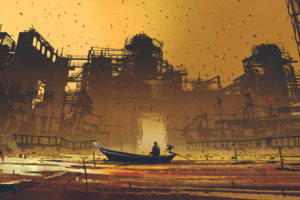
Due to its unique geography, the continent of Australia suffered a similar fate. Though it was roughly the same size as the continental United States, almost ninety percent of its population was concentrated along the coasts, including the bulk of its economic and governmental institutions. When the Corsica Event struck, the damage to Australia’s government, economy, and populace was so severe, it suffered a total collapse. Between the flooding on the coasts and the wildfires in the interior, the Australian government proved unable to sustain itself. Survivors were forced to fend for themselves and depend on local communities for assistance, as the government’s chain of command had completely failed.
In the aftermath, New Zealand proved to be the only nation in the region left largely unscathed, and the altruism they would show their neighbors in the following years would earn the small country the nickname “the Saint of Nations.”
Rather than focusing their efforts on rebuilding their own economy, New Zealand would spend nearly all of its resources during the reconstruction era on humanitarian aid to other Pacific nations. Under the leadership of Prime Minister Amaia Hayward, New Zealand shifted its entire economic focus to food production, maritime construction, and emergency housing development. In mere weeks, New Zealand had amassed a fleet of rescue vessels and deployed them across the Pacific, sending food and medical aid anywhere they could, and evacuating areas that were no longer livable.
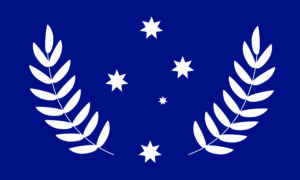
Coordinating with what little remained of the shattered leadership of their neighbors, New Zealand organized a massive resettlement effort, transporting refugees from devastated island nations to Australia, where they were also coordinating salvage and reconstruction efforts along the ravaged coast. With New Zealand’s aid and community cooperation, Australia formed a provisional democratic government and slowly began to wean itself off the need for New Zealand’s support.
The reconstruction in the Pacific progressed far more slowly than elsewhere in the world, and it is well-understood that New Zealand sacrificed an opportunity to keep pace with reconstruction of other developed nations in order to help their neighbors. However, the unprecedented international cooperation and focus on community has created a lasting sense of camaraderie among the nations of that region, which would later coalesce into the Oceanic Alliance. While other multinational alliances have stronger and more competitive economies, nations of the OA share a bond with one another that far transcends economics.
Africa
It would not be accurate to say that any region on Earth benefited directly from the Corsica Event, but its effects were far tamer on the African continent than anywhere else. Most of its terrain sits high above sea level, sparing it the severe flooding that devastated the islands and coastlines of other regions. Further, even at the end of the twenty-first century, the majority of Africans lived a largely offline existence, making the sweeping communications blackouts far less debilitating.
In fact, in the Corsica Event’s aftermath, many sub-Saharan African governments came upon a surprising realization: most of the so-called “First World” nations that had run the world for the past few centuries were now not much better off than they were.
One Botswana native, Khutsafalo Khumiso, built his presidential bid on the promise of building a new African superpower that could compete with the giants of the east, north, and west. His platform was successful, as were his social and economic programs, and he quickly began making good on his promise.

Nigeria, Kenya, Angola, and Ethiopia saw the effectiveness of Botswana’s plan, and adopted versions of their own, with other nations to follow. Khumiso established strong trade relations with these other nations, helping them shepherd forward their own progress and fostering sound relationships across borders. Under Khumiso’s doctrine, the developing nations of sub-Saharan Africa became allies to bolster one another rather than attempting to out-compete each other. This would evolve into the African Commonwealth: an insular multinational alliance of African nations focused on shared future prosperity.
Other than Morocco, and northern Algeria and Libya, which suffered the same widespread carnage as the rest of the Mediterranean, most of North Africa was spared the Corsica Event’s harshest effects. International relations among the Muslim world became tighter and more familial during the reconstruction period, leading to favorable trade agreements and open-border policies.
When the superluminal drive was invented, Lebanon, Egypt, Oman, Bahrain, Saudi Arabia, Kuwait, Qatar, and the United Arab Emirates were all early adopters of the new technology, commissioning Exotech Industries to build massive fleets of starships while most countries were still focusing on building simple housing. Facing the rapidly approaching total obsolescence of the fossil fuel industry upon which they had built their vast wealth, these nations chose to invest their future among the stars.
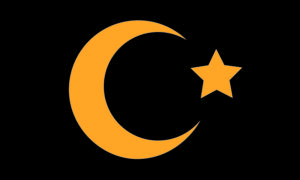
In no time at all, Arab nations had taken to space, quickly building dozens of extraplanetary mining operations rivaled only by those created by Exotech itself. Unlike other nations, however, they built few self-sustaining offworld colonies, and made no serious attempts to do anything more than mine other worlds for resources, bringing them back to Earth to enrich their existing economies. The result was a vast network of Arab mining outposts within and outside the solar system, all funneling their wealth back to the handful of Earth nations that owned them.
This confederated network of extraplanetary mining colonies, called the Outer Arab Emirates, traded freely with one another to maximize their potential, and over time the collective Arab nations that reaped their earnings came to be known by the same name. After decades of enriching their lands with offworld wealth, the nations of the Outer Arab Emirates have become technological marvels, home to the wealthiest, largest, and most ambitiously engineered cities on Earth. Outside their terrestrial borders, however, they have little presence in international or interplanetary politics, save for their extensive trade network.

Earth

“An upturned world is a treasure trove for one with an eye for opportunity. “
~Masuyo Kosawa
Even as humanity expands among the stars, Earth remains firmly grounded as the seat of human civilization. While colonies on other worlds are expanding rapidly, particularly on Mars and Showalter, more than ninety-eight percent of the human population remains concentrated on its ancestral homeworld.
The cataclysmic Corsica Event caused grievous devastation and loss of life on a scale never before seen in all of human existence. In a matter of days, Earth’s population of 10.5 billion was reduced by 978 million, and the global destruction forever changed Earth’s geography.
The most noticeable physical change the Earth experienced after the Corsica Event was the dramatic 60-foot rise in global sea level. This alone completely reshaped Earth’s coastlines, decreased the size of both ice caps, and increased global temperatures. Most of the deaths during the Corsica Event occurred along coastlines as colossal tsunamis swept into port cities and beachfront communities and never receded. Many peninsula regions, such as Florida, were cut off from the mainland, turning into islands, while many smaller islands were hit so badly by the rising waves that their populations were entirely wiped out. The floodplains of major rivers were invaded by the ocean, transforming them into bays and seas, such as the Lafayette Sea that formed in the Mississippi delta.
While inland regions were largely unaffected by the increase in sea level, they were not entirely spared the destruction. Hurricane storms covered most of Earth’s largest landmasses, ravaging them with high-speed winds and flooding. Electric storms caused monstrous wildfires in the North American west and the Australian Outback. Mild to severe earthquakes struck nearly every fault line on Earth simultaneously.
Numerous thermonuclear explosions occurred across the Earth, though it remains unclear how many of these were caused by the Event itself and how many were human attempts to stop it. Several nuclear reactors melted down during or right after the Corsica Event. Many regions across the Earth remain irradiated to this day.

Some of the Corsica tech caused additional effects that cannot yet be explained by science. Massive electromagnetic disturbances swept across most of the Earth, causing its natural electromagnetic field to fluctuate erratically throughout the event, though this effect was not permanent. There are anecdotal accounts of strange visual distortions in the atmosphere, gravitational anomalies, and objects materializing and dematerializing out of thin air. While most of these stranger effects were not reliably documented and did not linger after the Event ended, there are still a few isolated areas across the Earth where space-time itself seems to be off-kilter.
The devastation of the Corsica Event had a tremendous sociopolitical impact. Some governments collapsed, some were restructured, and a scant few who had been spared the brunt of the Corsica Event’s damages were able to take advantage of the suddenly leveled playing field to elevate their economies.
North America
One of the most dramatic regime changes occurred in North America. The United States struggled to adapt during the reconstruction years, thanks in large part to the actions of its controversial populist president Samuel Garlough.
The Corsica Event struck during Garlough’s election year, and by the time of his induction the country was in a state of social and economic upheaval never seen in its history. Against the counsel of his advisors, Garlough devoted most of the country’s emergency relief funds to the construction of a series of levies and seawalls in a futile attempt to reclaim America’s flooded port cities. Of these efforts, only the Manhattan Seawall project was successful, and the other projects were gradually abandoned in various stages of completion.
Garlough’s vain attempts at restoring unsalvageable cities led to even more unrest and desperation among communities nationwide. Riots broke out across the country and approval ratings hit record lows as the American people watched their president dump resources they desperately needed into the sea. When Garlough managed against all odds to win his reelection bid, division among the American people became too much to bear.

Twelve American states signed the Recusance Pact of 2096, announcing their formal secession from the union in an event that would come to be known as the Great American Schism. The American government lacked the resources to contest this act, and the secession was conducted without large-scale resistance.
Canada was in the process of shedding the last of its monarchial connections, and as part of their governmental restructuring, they extended an invitation to annex the newly seceded American states. This was accepted, and the United North American Republic was born.
This crippled the US government further, and their losses continued to mount. With the loss of the entire Pacific coastline, its oceanic trade capabilities were instantly halved. That same factor effectively cut off supply lines to Alaska and Hawaii, and the two states had little choice but to also secede in the following years, Alaska joining the UNAR and Hawaii joining the newly formed Oceanic Alliance as an independent nation. More than two-thirds of Florida had sunk into the ocean, leaving only a fraction of the panhandle and a swamped island in the Gulf of Mexico. The once great fifty United States had been reduced to 36, and the strength of its economy was already eclipsed by its northern neighbor.
To the immediate south, the Corsica Event had inflicted some of its deadliest carnage. The island nations of the Caribbean were all but obliterated when the tsunamis hit, and some of the smaller islands had been completely consumed by the sea. The larger islands such as Cuba, Haiti, and the Dominican Republic were brutally ravaged, and most Caribbean nations that weren’t completely destroyed still saw their governments collapse in the aftermath.
The devastation and chaos resulted in a mass displacement of Caribbean islanders. Thousands of refugees from every Caribbean nation resettled in the southeastern regions of the United States, taking up residence in the abandoned suburban buildings on the flooded shoreline. The weakened United States government lacked the resources to oppose this mass migration, and soon a largely self-governing nation of Caribbean immigrants had established itself along the coast of the Gulf of Mexico and the Lafayette Sea. While gang warfare was a serious problem in its early days, several of the more influential gangs eventually banded together to protect the community as a whole. The largest of these gangs, a Haitian group called the Mon Ki Pa Nwaye, evolved into a semi-democratic governing body, managing the needs of the community, conducting trade, and protecting their people from outside forces.
South America
South America faired poorly during the Corsica Event, and many of its less stable governments fell to bloody anarchy in its aftermath. Venezuela, Colombia, and Ecuador suffered the simultaneous losses of their executive government leadership, causing tremendous upheaval which culminated in three contiguous civil wars. This conflict, later called the Guerra Rabiosa, or “Rabid War,” was brief but intensely bloody and chaotic. By the time the three nations were able to re-establish order, the borders between them had to be redrawn entirely, and the ownership of some regions remains hotly contested to this day.

Bolivia and El Salvador also suffered tumultuous transitions of power, but managed to avoid all-out war. Guyana, Suriname, and French Guiana experienced a massive refugee crisis from Venezuelans fleeing the Guerra Rabiosa and Caribbean islanders displaced by the Corsica Event’s floods. Their economies were not strong enough to accommodate the sudden influx on top of their own damages, and sweeping famines plagued the countries for years to come.
Uruguay and Brazil faired better than most, holding onto strong economies after the Corsica Event as their governments coordinated effective reconstruction efforts. Brazil was forced to bolster its military forces to protect its northern border during the Guerra Rabiosa, and it would ultimately be Brazilian intermediaries who would negotiate the ceasefires between warring factions in the destabilized region.
Europe

Historians and scientists generally agree that, though its effects were largely decentralized across the globe, the Corsica Event began and ended somewhere in the Mediterranean Sea. Some of the most extensive inland damage occurred in that region, particularly in southern France, Germany, and Italy.
In addition to the catastrophic death toll, countless historic and cultural landmarks and art pieces were destroyed. This, coupled with the state of the global economy, dealt a crippling blow to the vital European tourist industry, further crippling the region’s reconstruction.

The European Union strained as the needs of its member nations were imbalanced. Those less effected by the Corsica Event, such as the British Isles and the regions to the northeast of the Baltic Sea, chose to focus their resources on their own reconstruction rather than sharing what little they had with the devastated nations to the south. The EU fractured, only the most destitute nations remaining a part of it, clinging to one another as they struggled to pool their scant resources for mutual survival. This incarnation of the European Union would soon evolve into the Expansionary Coalition with the arrival of superluminal space travel technology. Though offworld resources have helped Europe recover to a degree in the ensuing decades, their economies remain on shaky footing.
Asia
The sheer vastness of Asia’s landmass served to diffuse the Corsica Event’s impact, to a degree. The coastal and island regions still suffered greatly, but many of the developed coastal areas along the Asian side of the “Ring of Fire” managed to bounce back faster than similar regions. Most of the major cities in Japan and along the China coast managed to endure, as their infrastructure at the end of the 21st century had some of the most sophisticated anti-tsunami countermeasures on Earth. Additionally, their post-Corsica recovery was aided by the Ming-Kosawa corporation, a Sino-Japanese construction and communications conglomerate that would go on to spearhead reconstruction efforts worldwide.

North Korea experienced a devastating barrage of large thermonuclear detonations during the Corsica Event. Whether these were caused directly by the Event itself, were an act of opportunistic violence by another nation, or were an intentional act of self-destruction remains unknown to this day, but the result was the near-total annihilation of the country’s population. Winds carried radioactive fallout across the South Korean border, leading to public health crises in the northern parts of that nation for decades to come.

India had been in the midst of a societal paradigm shift in the decades leading up to the Corsica Event, with its historically broad class disparity steadily narrowing year by year. Although the death toll and economic impact was no less grievous there than anywhere else, India managed to maintain its momentum thanks to strong leadership and a healthy social safety net. India managed to bounce back from the Corsica Event far quicker than most other nations, and quickly became one of the most influential governments in the new world.
While Russia initially suffered catastrophic losses during the Corsica Event, they were met with unexpected windfalls that aided their recovery. As the global climate warmed dramatically with the rise in sea level, large swaths of previously uninhabitable land in Siberia became temperate enough for human development. While the first two decades of reconstruction were slow due to poor infrastructure and political instability, the country eventually got back on its feet and now enjoys a thriving agrarian economy, becoming one of the world’s largest food producers.
Oceania
No area on Earth experienced greater devastation than the south Pacific. The island nations of Polynesia and Micronesia suffered a similar fate to the Caribbean Islanders, as hurricanes and tsunamis obliterated their homes and the rising sea engulfed much of their land forever. The drastic changes to the global climate meant their normal storm seasons would remain violent in the years to come, leaving their ancestral homes all but uninhabitable.

Due to its unique geography, the continent of Australia suffered a similar fate. Though it was roughly the same size as the continental United States, almost ninety percent of its population was concentrated along the coasts, including the bulk of its economic and governmental institutions. When the Corsica Event struck, the damage to Australia’s government, economy, and populace was so severe, it suffered a total collapse. Between the flooding on the coasts and the wildfires in the interior, the Australian government proved unable to sustain itself. Survivors were forced to fend for themselves and depend on local communities for assistance, as the government’s chain of command had completely failed.
In the aftermath, New Zealand proved to be the only nation in the region left largely unscathed, and the altruism they would show their neighbors in the following years would earn the small country the nickname “the Saint of Nations.”
Rather than focusing their efforts on rebuilding their own economy, New Zealand would spend nearly all of its resources during the reconstruction era on humanitarian aid to other Pacific nations. Under the leadership of Prime Minister Amaia Hayward, New Zealand shifted its entire economic focus to food production, maritime construction, and emergency housing development. In mere weeks, New Zealand had amassed a fleet of rescue vessels and deployed them across the Pacific, sending food and medical aid anywhere they could, and evacuating areas that were no longer livable.

Coordinating with what little remained of the shattered leadership of their neighbors, New Zealand organized a massive resettlement effort, transporting refugees from devastated island nations to Australia, where they were also coordinating salvage and reconstruction efforts along the ravaged coast. With New Zealand’s aid and community cooperation, Australia formed a provisional democratic government and slowly began to wean itself off the need for New Zealand’s support.
The reconstruction in the Pacific progressed far more slowly than elsewhere in the world, and it is well-understood that New Zealand sacrificed an opportunity to keep pace with reconstruction of other developed nations in order to help their neighbors. However, the unprecedented international cooperation and focus on community has created a lasting sense of camaraderie among the nations of that region, which would later coalesce into the Oceanic Alliance. While other multinational alliances have stronger and more competitive economies, nations of the OA share a bond with one another that far transcends economics.
Africa
It would not be accurate to say that any region on Earth benefited directly from the Corsica Event, but its effects were far tamer on the African continent than anywhere else. Most of its terrain sits high above sea level, sparing it the severe flooding that devastated the islands and coastlines of other regions. Further, even at the end of the twenty-first century, the majority of Africans lived a largely offline existence, making the sweeping communications blackouts far less debilitating.
In fact, in the Corsica Event’s aftermath, many sub-Saharan African governments came upon a surprising realization: most of the so-called “First World” nations that had run the world for the past few centuries were now not much better off than they were.
One Botswana native, Khutsafalo Khumiso, built his presidential bid on the promise of building a new African superpower that could compete with the giants of the east, north, and west. His platform was successful, as were his social and economic programs, and he quickly began making good on his promise.

Nigeria, Kenya, Angola, and Ethiopia saw the effectiveness of Botswana’s plan, and adopted versions of their own, with other nations to follow. Khumiso established strong trade relations with these other nations, helping them shepherd forward their own progress and fostering sound relationships across borders. Under Khumiso’s doctrine, the developing nations of sub-Saharan Africa became allies to bolster one another rather than attempting to out-compete each other. This would evolve into the African Commonwealth: an insular multinational alliance of African nations focused on shared future prosperity.
Other than Morocco, and northern Algeria and Libya, which suffered the same widespread carnage as the rest of the Mediterranean, most of North Africa was spared the Corsica Event’s harshest effects. International relations among the Muslim world became tighter and more familial during the reconstruction period, leading to favorable trade agreements and open-border policies.
When the superluminal drive was invented, Lebanon, Egypt, Oman, Bahrain, Saudi Arabia, Kuwait, Qatar, and the United Arab Emirates were all early adopters of the new technology, commissioning Exotech Industries to build massive fleets of starships while most countries were still focusing on building simple housing. Facing the rapidly approaching total obsolescence of the fossil fuel industry upon which they had built their vast wealth, these nations chose to invest their future among the stars.

In no time at all, Arab nations had taken to space, quickly building dozens of extraplanetary mining operations rivaled only by those created by Exotech itself. Unlike other nations, however, they built few self-sustaining offworld colonies, and made no serious attempts to do anything more than mine other worlds for resources, bringing them back to Earth to enrich their existing economies. The result was a vast network of Arab mining outposts within and outside the solar system, all funneling their wealth back to the handful of Earth nations that owned them.
This confederated network of extraplanetary mining colonies, called the Outer Arab Emirates, traded freely with one another to maximize their potential, and over time the collective Arab nations that reaped their earnings came to be known by the same name. After decades of enriching their lands with offworld wealth, the nations of the Outer Arab Emirates have become technological marvels, home to the wealthiest, largest, and most ambitiously engineered cities on Earth. Outside their terrestrial borders, however, they have little presence in international or interplanetary politics, save for their extensive trade network.
“An upturned world is a treasure trove for one with an eye for opportunity. “
~Masuyo Kosawa
Even as humanity expands among the stars, Earth remains firmly grounded as the seat of human civilization. While colonies on other worlds are expanding rapidly, particularly on Mars and Showalter, more than ninety-eight percent of the human population remains concentrated on its ancestral homeworld.
The cataclysmic Corsica Event caused grievous devastation and loss of life on a scale never before seen in all of human existence. In a matter of days, Earth’s population of 10.5 billion was reduced by 978 million, and the global destruction forever changed Earth’s geography.
The most noticeable physical change the Earth experienced after the Corsica Event was the dramatic 60-foot rise in global sea level. This alone completely reshaped Earth’s coastlines, decreased the size of both ice caps, and increased global temperatures. Most of the deaths during the Corsica Event occurred along coastlines as colossal tsunamis swept into port cities and beachfront communities and never receded. Many peninsula regions, such as Florida, were cut off from the mainland, turning into islands, while many smaller islands were hit so badly by the rising waves that their populations were entirely wiped out. The floodplains of major rivers were invaded by the ocean, transforming them into bays and seas, such as the Lafayette Sea that formed in the Mississippi delta.
While inland regions were largely unaffected by the increase in sea level, they were not entirely spared the destruction. Hurricane storms covered most of Earth’s largest landmasses, ravaging them with high-speed winds and flooding. Electric storms caused monstrous wildfires in the North American west and the Australian Outback. Mild to severe earthquakes struck nearly every fault line on Earth simultaneously.
Numerous thermonuclear explosions occurred across the Earth, though it remains unclear how many of these were caused by the Event itself and how many were human attempts to stop it. Several nuclear reactors melted down during or right after the Corsica Event. Many regions across the Earth remain irradiated to this day.

Some of the Corsica tech caused additional effects that cannot yet be explained by science. Massive electromagnetic disturbances swept across most of the Earth, causing its natural electromagnetic field to fluctuate erratically throughout the event, though this effect was not permanent. There are anecdotal accounts of strange visual distortions in the atmosphere, gravitational anomalies, and objects materializing and dematerializing out of thin air. While most of these stranger effects were not reliably documented and did not linger after the Event ended, there are still a few isolated areas across the Earth where space-time itself seems to be off-kilter.
The devastation of the Corsica Event had a tremendous sociopolitical impact. Some governments collapsed, some were restructured, and a scant few who had been spared the brunt of the Corsica Event’s damages were able to take advantage of the suddenly leveled playing field to elevate their economies.
North America
One of the most dramatic regime changes occurred in North America. The United States struggled to adapt during the reconstruction years, thanks in large part to the actions of its controversial populist president Samuel Garlough.
The Corsica Event struck during Garlough’s election year, and by the time of his induction the country was in a state of social and economic upheaval never seen in its history. Against the counsel of his advisors, Garlough devoted most of the country’s emergency relief funds to the construction of a series of levies and seawalls in a futile attempt to reclaim America’s flooded port cities. Of these efforts, only the Manhattan Seawall project was successful, and the other projects were gradually abandoned in various stages of completion.
Garlough’s vain attempts at restoring unsalvageable cities led to even more unrest and desperation among communities nationwide. Riots broke out across the country and approval ratings hit record lows as the American people watched their president dump resources they desperately needed into the sea. When Garlough managed against all odds to win his reelection bid, division among the American people became too much to bear.

Twelve American states signed the Recusance Pact of 2096, announcing their formal secession from the union in an event that would come to be known as the Great American Schism. The American government lacked the resources to contest this act, and the secession was conducted without large-scale resistance.
Canada was in the process of shedding the last of its monarchial connections, and as part of their governmental restructuring, they extended an invitation to annex the newly seceded American states. This was accepted, and the United North American Republic was born.
This crippled the US government further, and their losses continued to mount. With the loss of the entire Pacific coastline, its oceanic trade capabilities were instantly halved. That same factor effectively cut off supply lines to Alaska and Hawaii, and the two states had little choice but to also secede in the following years, Alaska joining the UNAR and Hawaii joining the newly formed Oceanic Alliance as an independent nation. More than two-thirds of Florida had sunk into the ocean, leaving only a fraction of the panhandle and a swamped island in the Gulf of Mexico. The once great fifty United States had been reduced to 36, and the strength of its economy was already eclipsed by its northern neighbor.
To the immediate south, the Corsica Event had inflicted some of its deadliest carnage. The island nations of the Caribbean were all but obliterated when the tsunamis hit, and some of the smaller islands had been completely consumed by the sea. The larger islands such as Cuba, Haiti, and the Dominican Republic were brutally ravaged, and most Caribbean nations that weren’t completely destroyed still saw their governments collapse in the aftermath.
The devastation and chaos resulted in a mass displacement of Caribbean islanders. Thousands of refugees from every Caribbean nation resettled in the southeastern regions of the United States, taking up residence in the abandoned suburban buildings on the flooded shoreline. The weakened United States government lacked the resources to oppose this mass migration, and soon a largely self-governing nation of Caribbean immigrants had established itself along the coast of the Gulf of Mexico and the Lafayette Sea. While gang warfare was a serious problem in its early days, several of the more influential gangs eventually banded together to protect the community as a whole. The largest of these gangs, a Haitian group called the Mon Ki Pa Nwaye, evolved into a semi-democratic governing body, managing the needs of the community, conducting trade, and protecting their people from outside forces.
South America
South America faired poorly during the Corsica Event, and many of its less stable governments fell to bloody anarchy in its aftermath. Venezuela, Colombia, and Ecuador suffered the simultaneous losses of their executive government leadership, causing tremendous upheaval which culminated in three contiguous civil wars. This conflict, later called the Guerra Rabiosa, or “Rabid War,” was brief but intensely bloody and chaotic. By the time the three nations were able to re-establish order, the borders between them had to be redrawn entirely, and the ownership of some regions remains hotly contested to this day.

Bolivia and El Salvador also suffered tumultuous transitions of power, but managed to avoid all-out war. Guyana, Suriname, and French Guiana experienced a massive refugee crisis from Venezuelans fleeing the Guerra Rabiosa and Caribbean islanders displaced by the Corsica Event’s floods. Their economies were not strong enough to accommodate the sudden influx on top of their own damages, and sweeping famines plagued the countries for years to come.
Uruguay and Brazil faired better than most, holding onto strong economies after the Corsica Event as their governments coordinated effective reconstruction efforts. Brazil was forced to bolster its military forces to protect its northern border during the Guerra Rabiosa, and it would ultimately be Brazilian intermediaries who would negotiate the ceasefires between warring factions in the destabilized region.
Europe

Historians and scientists generally agree that, though its effects were largely decentralized across the globe, the Corsica Event began and ended somewhere in the Mediterranean Sea. Some of the most extensive inland damage occurred in that region, particularly in southern France, Germany, and Italy.
In addition to the catastrophic death toll, countless historic and cultural landmarks and art pieces were destroyed. This, coupled with the state of the global economy, dealt a crippling blow to the vital European tourist industry, further crippling the region’s reconstruction.

The European Union strained as the needs of its member nations were imbalanced. Those less effected by the Corsica Event, such as the British Isles and the regions to the northeast of the Baltic Sea, chose to focus their resources on their own reconstruction rather than sharing what little they had with the devastated nations to the south. The EU fractured, only the most destitute nations remaining a part of it, clinging to one another as they struggled to pool their scant resources for mutual survival. This incarnation of the European Union would soon evolve into the Expansionary Coalition with the arrival of superluminal space travel technology. Though offworld resources have helped Europe recover to a degree in the ensuing decades, their economies remain on shaky footing.
Asia
The sheer vastness of Asia’s landmass served to diffuse the Corsica Event’s impact, to a degree. The coastal and island regions still suffered greatly, but many of the developed coastal areas along the Asian side of the “Ring of Fire” managed to bounce back faster than similar regions. Most of the major cities in Japan and along the China coast managed to endure, as their infrastructure at the end of the 21st century had some of the most sophisticated anti-tsunami countermeasures on Earth. Additionally, their post-Corsica recovery was aided by the Ming-Kosawa corporation, a Sino-Japanese construction and communications conglomerate that would go on to spearhead reconstruction efforts worldwide.

North Korea experienced a devastating barrage of large thermonuclear detonations during the Corsica Event. Whether these were caused directly by the Event itself, were an act of opportunistic violence by another nation, or were an intentional act of self-destruction remains unknown to this day, but the result was the near-total annihilation of the country’s population. Winds carried radioactive fallout across the South Korean border, leading to public health crises in the northern parts of that nation for decades to come.

India had been in the midst of a societal paradigm shift in the decades leading up to the Corsica Event, with its historically broad class disparity steadily narrowing year by year. Although the death toll and economic impact was no less grievous there than anywhere else, India managed to maintain its momentum thanks to strong leadership and a healthy social safety net. India managed to bounce back from the Corsica Event far quicker than most other nations, and quickly became one of the most influential governments in the new world.
While Russia initially suffered catastrophic losses during the Corsica Event, they were met with unexpected windfalls that aided their recovery. As the global climate warmed dramatically with the rise in sea level, large swaths of previously uninhabitable land in Siberia became temperate enough for human development. While the first two decades of reconstruction were slow due to poor infrastructure and political instability, the country eventually got back on its feet and now enjoys a thriving agrarian economy, becoming one of the world’s largest food producers.
Oceania
No area on Earth experienced greater devastation than the south Pacific. The island nations of Polynesia and Micronesia suffered a similar fate to the Caribbean Islanders, as hurricanes and tsunamis obliterated their homes and the rising sea engulfed much of their land forever. The drastic changes to the global climate meant their normal storm seasons would remain violent in the years to come, leaving their ancestral homes all but uninhabitable.

Due to its unique geography, the continent of Australia suffered a similar fate. Though it was roughly the same size as the continental United States, almost ninety percent of its population was concentrated along the coasts, including the bulk of its economic and governmental institutions. When the Corsica Event struck, the damage to Australia’s government, economy, and populace was so severe, it suffered a total collapse. Between the flooding on the coasts and the wildfires in the interior, the Australian government proved unable to sustain itself. Survivors were forced to fend for themselves and depend on local communities for assistance, as the government’s chain of command had completely failed.
In the aftermath, New Zealand proved to be the only nation in the region left largely unscathed, and the altruism they would show their neighbors in the following years would earn the small country the nickname “the Saint of Nations.”
Rather than focusing their efforts on rebuilding their own economy, New Zealand would spend nearly all of its resources during the reconstruction era on humanitarian aid to other Pacific nations. Under the leadership of Prime Minister Amaia Hayward, New Zealand shifted its entire economic focus to food production, maritime construction, and emergency housing development. In mere weeks, New Zealand had amassed a fleet of rescue vessels and deployed them across the Pacific, sending food and medical aid anywhere they could, and evacuating areas that were no longer livable.

Coordinating with what little remained of the shattered leadership of their neighbors, New Zealand organized a massive resettlement effort, transporting refugees from devastated island nations to Australia, where they were also coordinating salvage and reconstruction efforts along the ravaged coast. With New Zealand’s aid and community cooperation, Australia formed a provisional democratic government and slowly began to wean itself off the need for New Zealand’s support.
The reconstruction in the Pacific progressed far more slowly than elsewhere in the world, and it is well-understood that New Zealand sacrificed an opportunity to keep pace with reconstruction of other developed nations in order to help their neighbors. However, the unprecedented international cooperation and focus on community has created a lasting sense of camaraderie among the nations of that region, which would later coalesce into the Oceanic Alliance. While other multinational alliances have stronger and more competitive economies, nations of the OA share a bond with one another that far transcends economics.
Africa
It would not be accurate to say that any region on Earth benefited directly from the Corsica Event, but its effects were far tamer on the African continent than anywhere else. Most of its terrain sits high above sea level, sparing it the severe flooding that devastated the islands and coastlines of other regions. Further, even at the end of the twenty-first century, the majority of Africans lived a largely offline existence, making the sweeping communications blackouts far less debilitating.
In fact, in the Corsica Event’s aftermath, many sub-Saharan African governments came upon a surprising realization: most of the so-called “First World” nations that had run the world for the past few centuries were now not much better off than they were.
One Botswana native, Khutsafalo Khumiso, built his presidential bid on the promise of building a new African superpower that could compete with the giants of the east, north, and west. His platform was successful, as were his social and economic programs, and he quickly began making good on his promise.

Nigeria, Kenya, Angola, and Ethiopia saw the effectiveness of Botswana’s plan, and adopted versions of their own, with other nations to follow. Khumiso established strong trade relations with these other nations, helping them shepherd forward their own progress and fostering sound relationships across borders. Under Khumiso’s doctrine, the developing nations of sub-Saharan Africa became allies to bolster one another rather than attempting to out-compete each other. This would evolve into the African Commonwealth: an insular multinational alliance of African nations focused on shared future prosperity.
Other than Morocco, and northern Algeria and Libya, which suffered the same widespread carnage as the rest of the Mediterranean, most of North Africa was spared the Corsica Event’s harshest effects. International relations among the Muslim world became tighter and more familial during the reconstruction period, leading to favorable trade agreements and open-border policies.
When the superluminal drive was invented, Lebanon, Egypt, Oman, Bahrain, Saudi Arabia, Kuwait, Qatar, and the United Arab Emirates were all early adopters of the new technology, commissioning Exotech Industries to build massive fleets of starships while most countries were still focusing on building simple housing. Facing the rapidly approaching total obsolescence of the fossil fuel industry upon which they had built their vast wealth, these nations chose to invest their future among the stars.

In no time at all, Arab nations had taken to space, quickly building dozens of extraplanetary mining operations rivaled only by those created by Exotech itself. Unlike other nations, however, they built few self-sustaining offworld colonies, and made no serious attempts to do anything more than mine other worlds for resources, bringing them back to Earth to enrich their existing economies. The result was a vast network of Arab mining outposts within and outside the solar system, all funneling their wealth back to the handful of Earth nations that owned them.
This confederated network of extraplanetary mining colonies, called the Outer Arab Emirates, traded freely with one another to maximize their potential, and over time the collective Arab nations that reaped their earnings came to be known by the same name. After decades of enriching their lands with offworld wealth, the nations of the Outer Arab Emirates have become technological marvels, home to the wealthiest, largest, and most ambitiously engineered cities on Earth. Outside their terrestrial borders, however, they have little presence in international or interplanetary politics, save for their extensive trade network.



